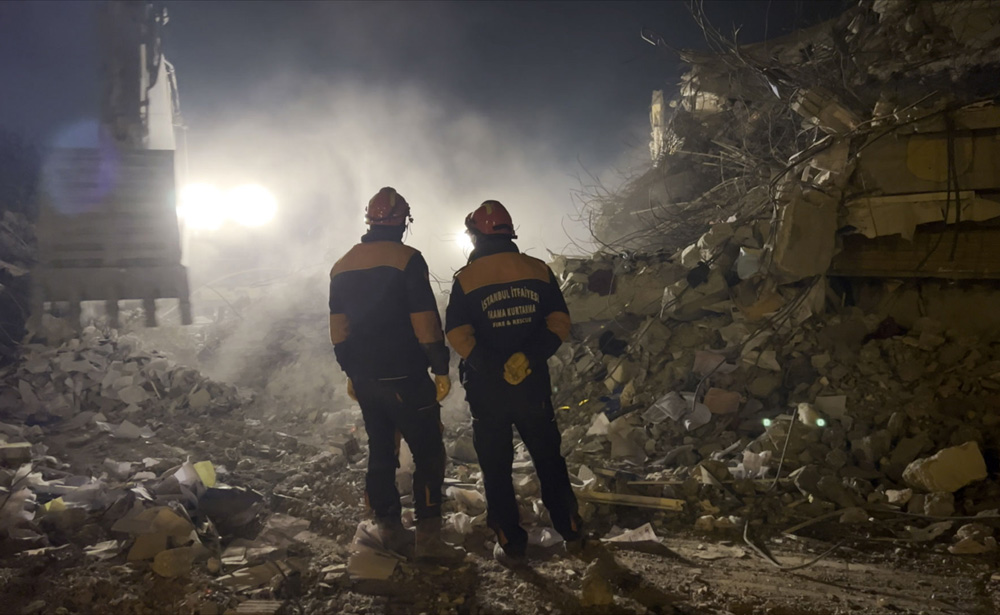Waad al-Kateab thought she had seen the worst during the seven years she spent making her previous film “For Sama,” diligently filming everything that happened when her native Syria crumbled under the brutal regime of Bashar al-Assad and her eventual departure when it was no longer safe to live in Aleppo. When international media couldn’t get cameras in, the footage she captured would offer an especially rare perspective on the destruction wreaked by civil war in the region and beyond offering her baby daughter of the title a chance to see the country of her heritage before her family had to leave for good, the world had no choice to take notice, acknowledged with an Oscar nomination for demonstrating the true power a film can have, but more rewarding for al-Kateab and co-director Edward Watts by raising awareness globally of the plight of everyday Syrians.
It is why every call she made on February 6, 2023 upon learning that a massive 7.8 earthquake touched down in central Turkey and northwestern Syria involved two questions – one if her family and friends were okay and two, whether they could start filming on their phones what was transpiring when so much of the area had been reduced to rubble. While al-Kateab couldn’t have expected any of this to end up being the foundation for another film, simply knowing the value of documentation from her first as far as encouraging humanitarian aid, the director ended up with a powerful new feature compiled from footage shot by Fadi Alhalabi, a cinematographer who al-Kateab met working together on “The White Helmets,” and Fuad Sayedissa, among others, that details the devastation they personally experienced when their families were living in a building in Antakya called The Rönesans Residence, home to nearly 1000 people in 249 flats, that toppled over as a result of the quake.
While scenes of the catastrophe made international airwaves at the time, al-Kateab goes deeper than the obvious tragedy in “Death Without Mercy,” which is every bit as heartbreaking as you’d expect with a death toll of over 50,000 including members of Fadi and Fuad’s families. But with all the footage that they managed to shoot through their pain, al-Kateab is able to illustrate a number of factors that have exacerbated their suffering and could be prevented, from Fadi being stopped at the Syrian/Turkish border as he worries about his brother’s whereabouts and unable to cross even when it’s clearly an emergency to the increasing possibility that the Residence was more susceptible to damage when a zoning amnesty in 2018 allowed for far more permissive building permits when it came to safety regulations. Making this even more unfathomable is how al-Kateab considers a community in Ankara made up of refugees from Syria, who resettled in Turkey after fleeing from war, that will never feel entirely at ease again and have to rebuild their lives once more after even greater loss.
“Death Without Mercy” is about as tough a sit as its title implies, but it is not without hope when as al-Kateab is quick to note, it’s the product of a collective action and all its participants set aside their own personal trauma when they knew they could contribute to a cause greater than themselves. What resulted is an undeniable record of the immediate aftermath of the quake and a testament to the strength that people can draw on to endure the unthinkable and with the film following up its premiere at Sheffield Film Fest earlier this year with a theatrical release this week in the States, al-Kateab graciously took the time to talk about how the remarkable film came together, the more personal reasons it was difficult to work with footage she hadn’t shot herself and the healing power of sharing experiences that the film is still facilitating as it enters the world.
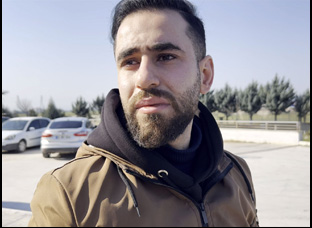
Not at all. It was a very shocking moment for us. We’ve been through a lot. We’ve seen really scary and devastating moments in our life, but this was just beyond everything we’ve experienced before. So I didn’t think of a film, but I was trying to tell everyone there, “Please film, please film,” more as documentation. Especially with Fadi [who’s a cinematographer professionally], we’re really good friends and we have so many friends between us, I was just telling them, “Please film,” because we had a feeling that someone would be alive, and we wanted to catch this beautiful, hopeful story. But five months later, when Sheila [Nevins at MTV Documentary Films] reached out to me, it was very clear for me — I had access, I knew these people and everything about [the situation], I didn’t need to do any research, so from that moment when we talked about the film, it was so clear how and what is it about exactly.
Relative to “For Sama” where you were filming for the better part of a decade and it was all your own footage, was it a different experience, happening so quickly and working with footage that was coming in from others?
Yeah, it was totally the opposite. In “For Sama,” I was there, it was my camera. I was living through this, but I was very far away from this, trying just to see and understand because you get all this footage and even before thinking about it as a film, you just want to see, you just want to make sure these people are okay. And in such a situation like this, Fadi is a very dear friend and I’m in London, [wondering] what I’m going to do for him when he’s struggling with all of this. So I had all this material, watching people I care about going through this and [feeling] this huge responsibility to make it right and what is very similar to “For Sama” is how much I care about this film and how much this is personal to me and to the people in the film. That’s why it was so painful more than what I’ve witnessed myself in “For Sama” because I love these people and I know what they’ve been through. I know how difficult it is to lose someone or to live on that hope of waiting for someone.
I managed to go back [to Turkey] six months after the earthquake [for] all the master interviews and the visit to the graveyards and to follow up with the story and what I think really made this film work was the trust I have with these people. They were in this unbearable situation with all this grief and sadness, but also they put all the trust in me and they weren’t hesitating to share all these painful moments and all this amazing footage they have. Some of the material, [such as] Safa’s voice recording from underneath the rubble, this is just something I couldn’t imagine when Safa was showing me this. So it came as a collective effort with our history together and our shared belief that the only way to face this tragedy to tell the story and carry it on and try to talk about it outside.
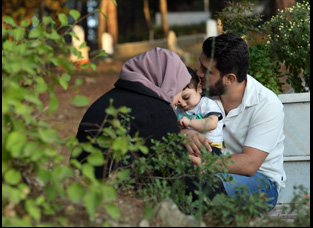
It all goes back to the same point — the trust. These people are dear friends and have other friends and families with them, and that at that moment when this all happened, all this footage was created without any desire to make a film. It’s a very natural response as Syrians who’ve been through a lot before, just to document everything, so it’s all about family and friends around who were with him trying to do something. Part of that was Fuad asking them, “Please film, I want rescue forces to come.” And when Fadi was not even at his family building, but still stuck in Syria, some friends went there trying to film the building for Fadi to show him [what was happening]. There’s this unbelievable video when our friends were calling for [Fadi’s brother] Yeman from underneath the rubble, just sending this video to Fadi because Fadi can’t be there, even physically.
This all came because we are one community, we understand each other and we try just to stand next to each other. With this huge feeling of hopelessness and helplessness, the camera is the only thing we have, and especially when so many of these people are activists, they’ve been filming for years in Syria. I’d seen so much of this footage before even we talked about the film, but when we started talking about the film, it was like [putting together] a puzzle and everyone wanted to help. Everyone loves Fuad and Fadi, and they wanted to make the best film with what they have. Even someone random would hear that we are doing the film, and they were like, “Yeah, I have something about Fadi’s building,” so we collected so many materials just because people were desperate to tell the story. The news [outlets] were there for a couple of days and in countries, like the U.S., there was maybe one headline. But for us, it was the biggest thing we’ve faced, even with these 12 years of war in Syria. The earthquake was totally different, so everyone just wanted the story to be out and to be told, and it was important that they were the ones to tell it and I was just the tool to help make this happen.
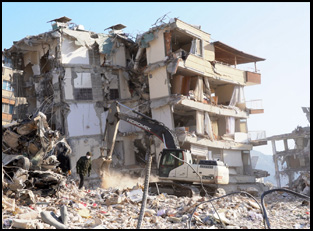
To be honest, when this happened, I couldn’t process it, even when we started to see all this material. Also, my mom, dad, and sister, and brother live in that area, so I was following that with them on the phone all the time to make sure they were okay. There was the big shock of the news [that] I couldn’t understand or process, and then when all this material came, and I started to see the details of every second with Fadi and Fuad and it was still too much to really process and understand. And all of this did not make me ready when I went there on the ground. It was just so heartbreaking, and to be standing there with Fadi, who’s not just the heart of the story, but also he was with us there as the cinematographer, [filming] all the master interviews including his own. He set up all the cameras, and for me to be there with this team who witnessed this and [saw] everything turned upside down, I was just so fragile and so heartbroken, but I was very shy to express any of this.
You have to be strong for them and to make this film right, to really do justice to everything they’ve been through. And when we went seven months later, so much of the rubble was already removed from Antakya, and for the audience who doesn’t know, all these cities are close to the border with Syria, so life is very similar and people [who fled Syria] started their whole life again in this area, so it’s like if our second home was destroyed again and emotionally, it was just so difficult for any Syrian to look at these beautiful cities that we thought was safe. We thought it was a new life, and then it was very, very heartbreaking.
That was a context that I really understood from this film. I know you knew Fadi professionally, but how did Fuad become the other person you follow in the film?
Fuad was 16 when he started working as an aid worker and he set up a local organization called Violet, now one of the biggest voluntary organizations in Syria. I know Fuad from his brother [in film production] at university and at that time, he was very young, like 16 and I wasn’t that old, I was 20, and that was at the beginning of the revolution. I knew Fuad as my friend’s younger brother, but through the revolution we started working together and I witnessed how much work he’d done and how big his organization started to be.
We were the same kind of community activists who do everything just to make something good within that situation, and I know his son Koutaiba, is same age as my daughter Sama, so we’d come across each other in so many places. With Fadi, we had Aleppo Media Center, which one of the best alternative media institutes that we have in Aleppo. Their office was just two blocks away from my house, so we used to see each other and talk a lot about everything when we were in Aleppo. He’s been covering stories of other people’s grief and hope and love for so many years, and then to find him in that position when his brother, Yaman, who was also a filmmaker, is the one who we lost, it was just very overwhelming. When you were in the siege in Aleppo [together], there was a lot of connection and a lot of memories and a lot of shared experience.
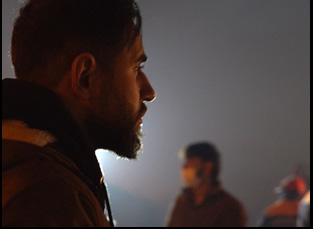
Yeah, we all felt we were let down again. We would have been abandoned again by the international community and that feeling really drove this film and why it was very important to make it right. Each one of these people has so many details within, and there were moments when we were doing the master interviews when [Fuad’s wife] Safa was sharing what she’d been through under the rubble on the camera when Fadi was filming, and when Fuad has Sami, their baby, in the next room and Fuad did not know so many of these details. Same when Fuad was talking about what happened when Safa was still in the hospital. There was no time to process this or to sit down and talk about this when each one has their own huge grief.
I can’t call it therapy — this is too big to put it this way, but [filming] was a way of sharing this pain and being able to understand it and talk about it together in a really safe and collective way where I could see how each one of them could see their pain being mirrored with other people, being understood. And the last scene in the film when Safa and Fuad are at the graveyard of their son, Koutiaba, Fadi was the one shooting this scene and I had the second camera standing, supporting him in what he’s doing, but I was impressed all the time in the resilience and the strength in the belief they were just trying to be strong for each other, but also for the film to be told in the right way.
What’s it been like sharing this with audiences?
I think it’s a very shocking and a very painful story, but also it’s very important to be told and to be heard and seen. There are so many tragedies, and we should understand and accept that the world today is not in a better place with what’s going on around the world. But each story deserves to be heard, and the questions that people ask us after screenings show you how people really care and how they really want also to do something to support or to help, whether that was on an individual level or on a bigger scale. It was really overwhelming in a good way and I would love to keep sharing that more and more and for people to come and see it and recognize that this pain and grief is something universal. It’s not related to one earthquake or one war in one place. It’s about how we as a human being can be compassionate and care about each other.
“Death Without Mercy” opens on October 11th in New York at the IFC Center and in Los Angeles at the Laemmle Glendale.




